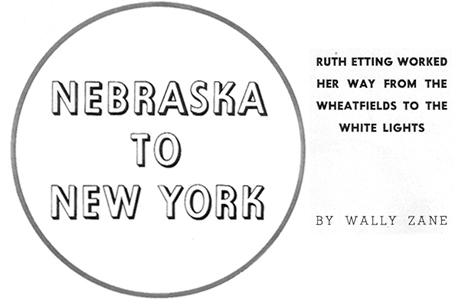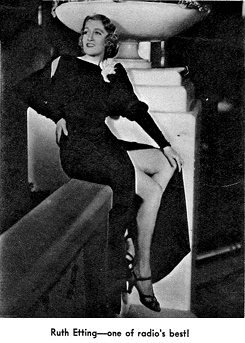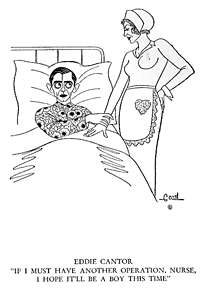FANNY ON THE PIANO
Tag: Florenz Ziegfeld
Times Square Tintypes: George White
SCHOOL FOR SCANDAL
Snapshot in Prose: Ruth Etting
This prose snapshot of songbird Ruth Etting might fairly be said to be a doctored “photo”—or at the very least retouched. For this profile, from the April 1935 issue of Popular Songs, makes no mention of Martin “Moe the Gimp” Snyder, a gangster to whom young Ruth was wed in 1922 and who had a major impact on her career.
After achieving huge success in radio, Broadway, recordings, and movies, Etting divorced Snyder in 1937, having fallen in love with her pianist, Myrl Alderman, who was nearly ten years her junior.
That old saying “Heaven has no fury like a mobster scorned” applies here, as Snyder soon plugged Alderman with a bullet, spending a year in jail before being released on appeal.
The surrounding scandal seems to have pulled the plug on Etting’s career, alas, though she would go on to marry Alderman and, one hopes, live happily ever after.

 HEN Ruth left her happy home on a Nebraska farm to go down to Chicago to study art, she hadn’t a thought in the world about cabaret entertaining, torch songs, crooners, radio broadcasting, Broadway song and dance shows, Florence Ziegfeld or Hollywood—yet all of these have played important parts in her eventual life.
HEN Ruth left her happy home on a Nebraska farm to go down to Chicago to study art, she hadn’t a thought in the world about cabaret entertaining, torch songs, crooners, radio broadcasting, Broadway song and dance shows, Florence Ziegfeld or Hollywood—yet all of these have played important parts in her eventual life. She wasn’t particularly concerned with the thought of being alone in a big strange city. Even if she had been, she would have gone anyway, for she had plenty of determination.
She wasn’t particularly concerned with the thought of being alone in a big strange city. Even if she had been, she would have gone anyway, for she had plenty of determination.In Your Hat, pt. 12

| If you took a rabbit out of those suckers’ hats They would squawk just the same: They all have two strikes on them When they are born. TEXAS GUINAN
|
“May every hat check bring you a fat check—and may no meanie neglect my Renee—who never wrecks hats each time she checks hats—Frances Williams.”
“Oh, look, I am in your book—thanks for letting me.”
“To Renee, who expects something clever from me but won’t get it.”
“To Renee, from her worst customer.”
“To a real and sweet girl, with loads of knockouts.
Tony Canzoneri,
Lightweight Champion of the World.”
“To Renee—
“Who takes what you give graciously. All life is a game of give and take. For what she takes she gives in a return a smile, a cheerful greeting and your belongings. May you go a long ways and prosper. Keep smiling Renee, it’s what we all go for.”
“To Renee—
Duchess of Sardi,
from
Baron George Jessel,
Colonel of the Bronx Grenadiers
And Vis-count of Brownsville.”
“You’ll always be Miss Shapiro to me—one of my best yarns. Sidney Skolsky
P.S. She sleeps in the raw!”
“My hat’s off to you. (Get it?) Je parle français aussi. (I hope that’s right).”
“My autograph I here inscribe,
A member of the organ tribe
Jesse Crawford,
Poet (?) of the Organ.”
“Keep your face towards the sun and the shadows will fall behind you.”
“A mon amie Renee en souvenir des Ziegfeld Follies 1931.”
“A hat girl who has more in her head than all the brains those hats cover. A little princess on a door mat—An oriental pearl in a suffocating shell—a ruby in a musty purse, but watch her.”
“To Renee. In memory of my first daughter of four kilos.”
“Because I like red-heads.”



